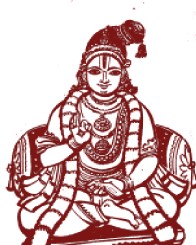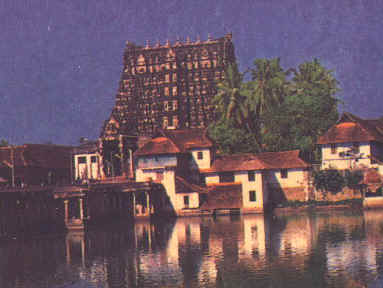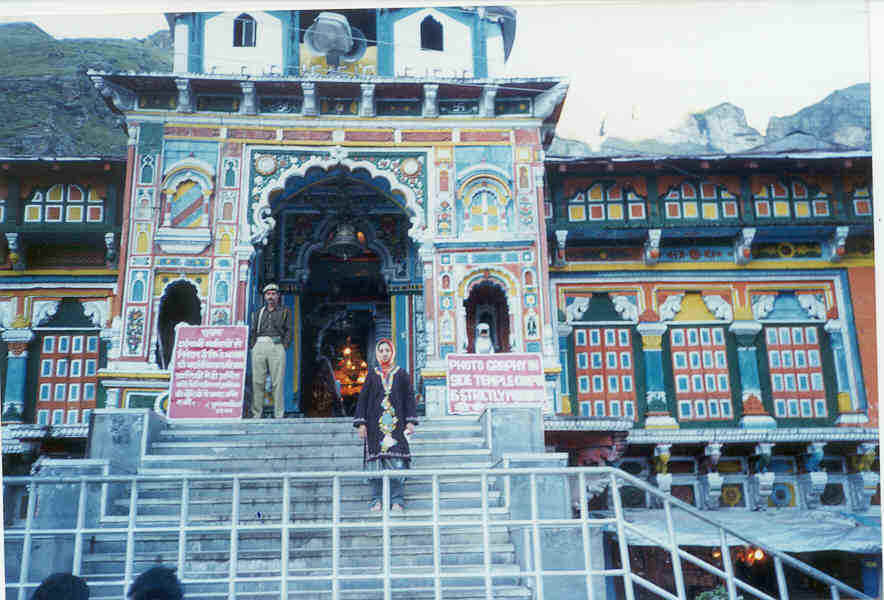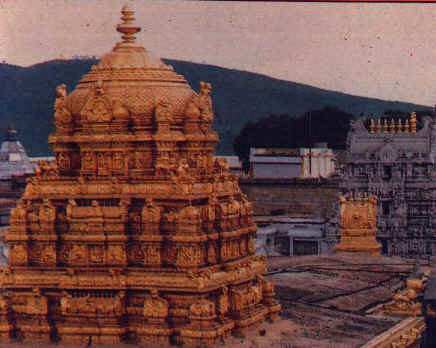Introduction
The Alwars The
Paasurams Naalaayira Divya Prabandam Divya Desams History of
Patronage Geographical Distribution State of these temples Iconography
Worship protocol Shivastalams
glorified by the Tevaram hymns
Divya Desam Index
Introduction: This special edition of
Templenet features the 108 temples and celestial Abodes of Vishnu revered in the tamil
hymns of the Alwars, of the 1st millennium CE.
 The Alwars: Sri Vaishnavism is one of
the pre-eminent traditions of Hinduism. An unbroken lineage of teachers, (the
Acharyas) and a wealth of literature in Tamil and in Sanskrit and the Vishishtadvaita
philosophy form the backbone of the Sri Vaishnava religion. Twelve saint (poet)
devotees - the great Alwars lived their lives dedicated to expressing their devotion
to MahaVishnu - considered to be the supreme manifestation of Divinity in the Vaishnava
system of beliefs.. These saints composed verses in chaste tamil, and
revitalized the religious spirit of the region, sparking off a renewal of devotional
worship in what is generally referred to as the Bhakti movement. The first of the twelve,
Peyalwar, Bhootattalwar and Poikaialwar lived in the first half of the first millennium
CE. The Alwars: Sri Vaishnavism is one of
the pre-eminent traditions of Hinduism. An unbroken lineage of teachers, (the
Acharyas) and a wealth of literature in Tamil and in Sanskrit and the Vishishtadvaita
philosophy form the backbone of the Sri Vaishnava religion. Twelve saint (poet)
devotees - the great Alwars lived their lives dedicated to expressing their devotion
to MahaVishnu - considered to be the supreme manifestation of Divinity in the Vaishnava
system of beliefs.. These saints composed verses in chaste tamil, and
revitalized the religious spirit of the region, sparking off a renewal of devotional
worship in what is generally referred to as the Bhakti movement. The first of the twelve,
Peyalwar, Bhootattalwar and Poikaialwar lived in the first half of the first millennium
CE.
The Paasurams: Srivilliputtur
in southern Tamilnadu, is home to Perialwar, and his foster daughter Andal; the
works of Andal are very well known to the tamil world. The Tiruppaavai hymns written by
Andal (a manifestation of the mother Goddess) are chanted in congregations throughout
Tamilnadu during the cold month of Margazhi, in the cool pre-dawn hours, in temples as
well as in the streets that surround temples. The 30 hymns constituting Tiruppavai have
been recorded by several artists, and the national radio station All India Radio (used to)
broadcast(s) a hymn each day throughout the month of Margazhi. Also composed by Andal is 'Vaaranam
Aayiram' (Kanaakkanden Tozhi), describing Andal's dream of her marriage to Narayanan
(Vishnu). This work is chanted during Sri Vaishnava weddings. A popular version of
Vaaranam Aayiram sung by S. Janaki hit the charts in 1990.
Amalanaadipiraan, a decad of 10 verses composed by Tiruppaanaalwar of Uraiyur, describing his ecstasy upon seeing the
image of Ranganathar at Tiruvarangam, is held in great reverence. Tondaradippodialwar has
composed several verses in praise of Ranganathar at Srirangam.
The most prolific poets of the Alwars were Nammalwar and Tirumangaialwar (8th - 9thcentury
CE). The collection of Nammalwar's works is referred to as Tiruvaimozhi.
The compilation of these verses is the revered Naalayira
Divya Prabandam. Credit for this compilation goes to Nadamuni (923 - 1023
CE), who upon hearing Nammalwar's verse 'Aaraavamude' being chanted at Kumbhakonam, researched into and compiled the works of all
of the Alwars. The lineage of spiritual leaders of the Sri Vaishnava way of life, held
these works in the highest regard, considering them equivalent to the Vedas. The Alwar
paasurams therefore have been chanted in temples for centuries together (in a manner
similar to that of chanting the Vedas in sanskrit).
The tradition of Arayar
Sevai involving the expressive recitation (enactment) of the paasurams
originated during the period of Nadamuni, at Srirangam. This tradition exists even today
at Srirangam, and at Srivilliputtur and Alwar
Tirunagari (and at Melkote in Karnataka). The descendants of the family of
Nadamuni are the torchbearers of this tradition.
Divya Desams: The verses of the
Alwars, speak of the glory of Vishnu, of instances from the puranams. of the devotion of
the Alwars and of the glory of the temples (and locales) enshrining Vishnu
(which they had visited). The entire decad of verses commencing with Amalanaadipiraan
praises Ranganathar at Srirangam. Some of these
verses only refer to (or address) temples in which Vishnu is enshrined as in the case of
Nammalwar's hymns referring to the deity enshrined in Srivaikuntham
in two verses in a decad of verses dedicated to Tiruppulinkudi.
Pillaipperumaal Iyengar's work Tirupati Andadi captures 108 of the shrines,
mentioned in the works of the Alwars. These shrines are hailed as Divya Desams, hallowed
by the hymns of the saints.
History of patronage: These
shrines have been held in reverence for centuries. In Tamilnadu where 84
of these shrines are situated, the Pallava rulers (as in Mahabalipuram, Nandipuravinnagaram),
and the Chola emperors (10th through the 13th centuries) provided for the construction (in
stone), expansion and upkeep of these shrines through generous endowments. The
Pandyas who followed continued this tradition. It was under the rule of the Vijayanagar
emperors that shrines such as Srirangam, Tirukkachhi and Tirupati
received the greatest extent of royal patronage. The Nayaka rulers of Madurai continued
this glorious tradition after the Vijayanagar rulers.
The shrines: 47 of the 108 Divya Desams
have been addressed only by Tirumangaialwar and 18 only by Nammalwar. While 2 are
addressed only by Tirumazhisaialwar, 1 by Kulasekharalwar and 1 by Perialwar, the
remaining 39 are addressed by hymns composed by more than one of the saints. In
combination with the other saints, Tirumangaialwar has addressed 83 of the 108 Divya
Desams and Nammalwar 35. While 247 verses are addressed to Srirangam - 202 are
addressed to Tirupati, 128 to Azhagar Koyil and only 7 to Kanchipuram (Tirukkachhi
Attigiri). The celestial abodes Tirupparkadal (The Milky Ocean) and Paramapadam
(Vaikuntham) get 51 and 36 verses each.
 Geographic distribution: 40
of the shrines are located in the fertile Chola kingdom and 22 are in Tondainaadu - around
Kanchipuram and Chennai. 2 are in Nadu Naadu (Tiruvahindrapuram and Tirukkovilur) and 18
are in Pandyanaadu. 13 of the shrines are in Malainaadu, of which 11 are in Kerala and 2
are in Kanyakumari district; therefore the total number of Divya Desams in Tamilnadu is
84. 11 Divyadesams are in Vada Naadu, or the northern lands - of which two, Tirupati and Ahobilam
are in Andhra Pradesh. 7 of these 11 are in Uttar Pradesh (such as Mathura, Ayodhya
, Badrinath etc.). , 1 in Nepal and 1 in
Gujarat. Two of the Divyadesams - Ksheerasaagaram
and Vaikuntham are celestial abodes. Geographic distribution: 40
of the shrines are located in the fertile Chola kingdom and 22 are in Tondainaadu - around
Kanchipuram and Chennai. 2 are in Nadu Naadu (Tiruvahindrapuram and Tirukkovilur) and 18
are in Pandyanaadu. 13 of the shrines are in Malainaadu, of which 11 are in Kerala and 2
are in Kanyakumari district; therefore the total number of Divya Desams in Tamilnadu is
84. 11 Divyadesams are in Vada Naadu, or the northern lands - of which two, Tirupati and Ahobilam
are in Andhra Pradesh. 7 of these 11 are in Uttar Pradesh (such as Mathura, Ayodhya
, Badrinath etc.). , 1 in Nepal and 1 in
Gujarat. Two of the Divyadesams - Ksheerasaagaram
and Vaikuntham are celestial abodes.
 Thus, 106 temples have been addressed by the Tamil Alwars, who were pillars
of the Sri Vaishnava tradition that was to evolve in Tamilnadu. The contrast in the nature
of these temples is stunning, given the diversity in the Indian subcontinent. Even a virtual visit to these 106 shrines across the
nation, is quite an experience, and is illustrative of this contrast, given the difference
in the nature of temples in the various regions such as the Kaveri basin, Andhra
Pradesh, Kerala, the Tirunelveli region, the Gangetic plains and the Himalayas. Thus, 106 temples have been addressed by the Tamil Alwars, who were pillars
of the Sri Vaishnava tradition that was to evolve in Tamilnadu. The contrast in the nature
of these temples is stunning, given the diversity in the Indian subcontinent. Even a virtual visit to these 106 shrines across the
nation, is quite an experience, and is illustrative of this contrast, given the difference
in the nature of temples in the various regions such as the Kaveri basin, Andhra
Pradesh, Kerala, the Tirunelveli region, the Gangetic plains and the Himalayas.
State of these temples: Some of
the Divya Desam shrines are grand monuments such as the Ranganathar Temple at Srirangam, Naachiyaar temple at Srivilliputtur, the Padmanabhaswamy temple at Tiruvanandapuram and the Varadaraja Perumaal temple at Kanchipuram, visited by
thousands. Badrinath, the northernmost of
the Divyadesams is a shrine venerated throughout India. Tirupati
(Tirumala) is the most visited of these 108 Divya Desams, and is held in great regard by
pilgrims all over the country. Tiruvallikkeni a
well visited shrine and a prominent landmarks in the modern city of Chennai, attracts
thousands of devotees during the Vaikuntha Ekadasi festival in the month of Margazhi. Ranganathar Temple at Srirangam, Naachiyaar temple at Srivilliputtur, the Padmanabhaswamy temple at Tiruvanandapuram and the Varadaraja Perumaal temple at Kanchipuram, visited by
thousands. Badrinath, the northernmost of
the Divyadesams is a shrine venerated throughout India. Tirupati
(Tirumala) is the most visited of these 108 Divya Desams, and is held in great regard by
pilgrims all over the country. Tiruvallikkeni a
well visited shrine and a prominent landmarks in the modern city of Chennai, attracts
thousands of devotees during the Vaikuntha Ekadasi festival in the month of Margazhi.
Some of the Divya Desams in Tamilnadu, stand as grand monuments gracefully located
away from the beaten track (Tirukkovilur, Sri Vaikuntham for example). Three of the Divya Desams are
sub shrines in the prakarams of other Divya Desams. The Tiruoorakam
(Ulagalanda Perumaal Koyil) houses the Divyadesams Oorakam, Neerakam,
Kaarakam and Kaarvaanam.
Two of the Divyadesams are subshrines in other temples. Nilattingal
Tundam is a shrine to Vishnu in the inner prakaram of the grand Ekambreswarar temple at Kanchipuram, while Kalvanoor is a shrine to Vishnu in the Kamakshiamman temple at Kanchipuram.Tiruchitrakootam, is located within the grand
Nataraja temple complex at Chidambaram.
Iconography: While in Saivite shrines, it is
the Shivalingam or the non-anthropomorphic form that is enshrined in the innermost
sanctum, it is the iconic form of Vishnu that is center of reverence in the 106 Divya
Desams. Vishnu is represented usually in one of three postures - reclining (Sayanam
or kidanda kolam) as in Kumbhakonam,
seated posture (irunda kolam) as in Tirupperai,
or standing (ninra kolam) as in Tirupati (Tirumala).
Worship protocol: While in all of the
Divya Desams in Tamilnadu (with the exception of Nilattingal
Tundam, Kalvanoor, Tiruvaattaru and Tiruvanpatisaaram)
the Vaishnava Agamic (Pancharatra or Vaikanasa) protocol of worship is followed, the
Kerala Tantram is followed in the Divyadesams in Malainadu. Worship services at Badrinath follow a protocol established during the period
of Adi Sankaracharya.
Festivals: Most of the Divya Desams in
Tamilnadu follow an elaborate tradition of festivals. The Margazhi festival, involving the
recital of the Alwar hymns - and the climax of the festival on the day of Vaikuntha
Ekadasi are traditions which have sustained for several centuries, enriching the cultural
life of the tamil region. The annual festival at the Kallazhagar
temple in the month of Chittirai, coinciding with the Bhramotsavam at the Madurai Meenakshi Sundareswarar temple imparts
a festive look to the entire region, drawing hundreds of thousands of visitors from all
over the state.
The Saivite Nayanmars lived
roughly during the same period as the Alwars. While Karaikkal Ammaiyaar and Tirumoolar
lived in the first half of the first millennium CE (the first of the Alwars are said to
belong to the same period), Appar and Sambandar the foremost of the Tevaram saints lived
in the 7th century. (Tirumangaialwar belonged to the 9th century while )
Sundaramurthy Nayanar lived in the 9th century CE. The Tevaram
hymns were rescued from obscurity and set to music by Nambiandar Nambi during the rule of
Rajaraja Chola I, roughly during the same period in which the Alwar Paasurams were
compiled by Nadamuni. 275 Shiva temples in the Indian subcontinent have been glorified
with at least a decad of 10 Tevaram verses (patikam) each of the Nayanmars (275 Tevara
Paadal Petra Stalams) , while 249 (others) have been addressed (referred to) by the
Tevaram (249 Tevara Vaipputtalams). Please visit the Abodes of Shiva for more information on the Nayanmars, the
Tevaram hymns and these shrines.
Templenet is proud to feature the 108 shrines and celestial Abodes of Vishnu revered by
the tamil hymns of the Alwar saints. Please send feedback on this special feature to
kanniks@templenet.com.
Welcome to a virtual tour of the 108
Divya Desams arranged by region.
Kanniks Kannikeswaran
Dec 31, 1999
|